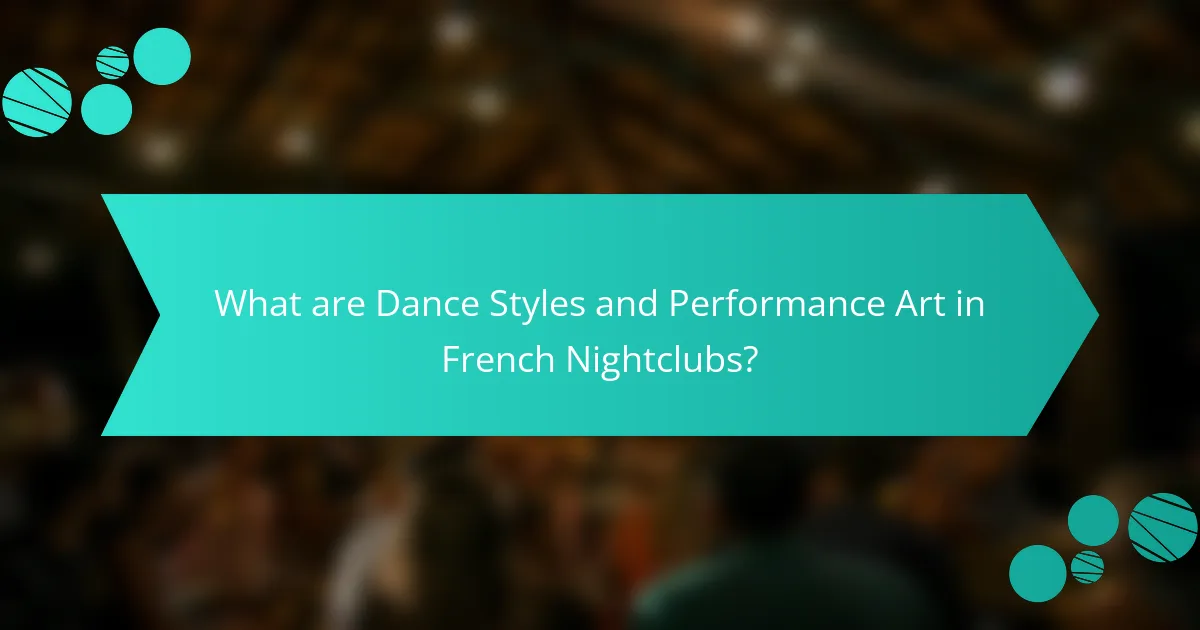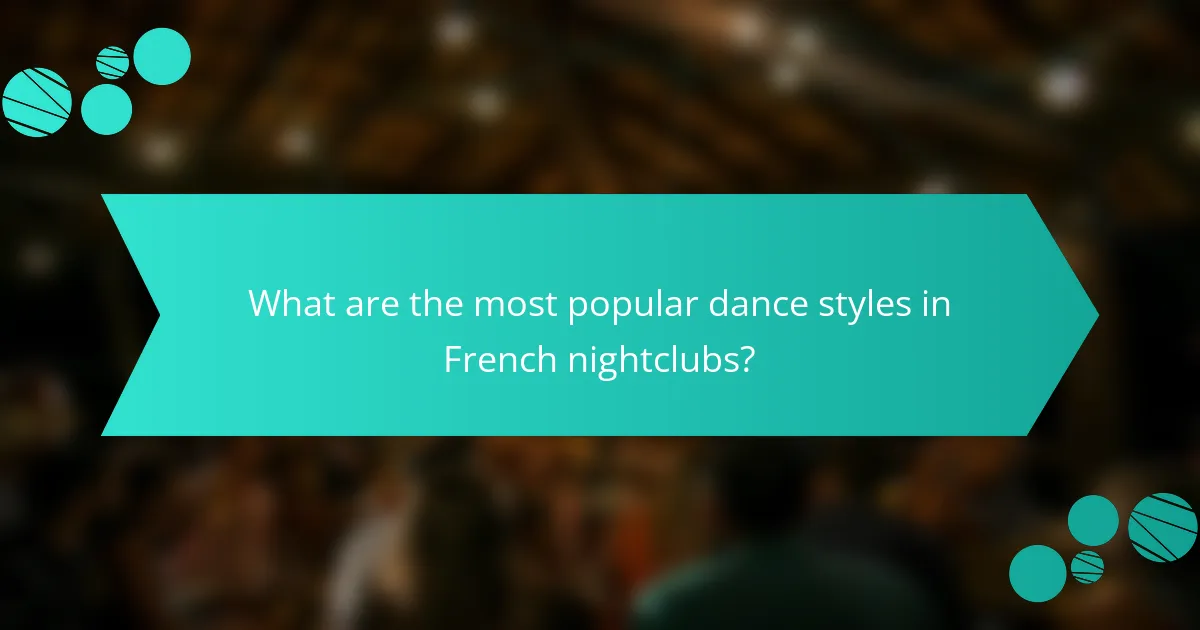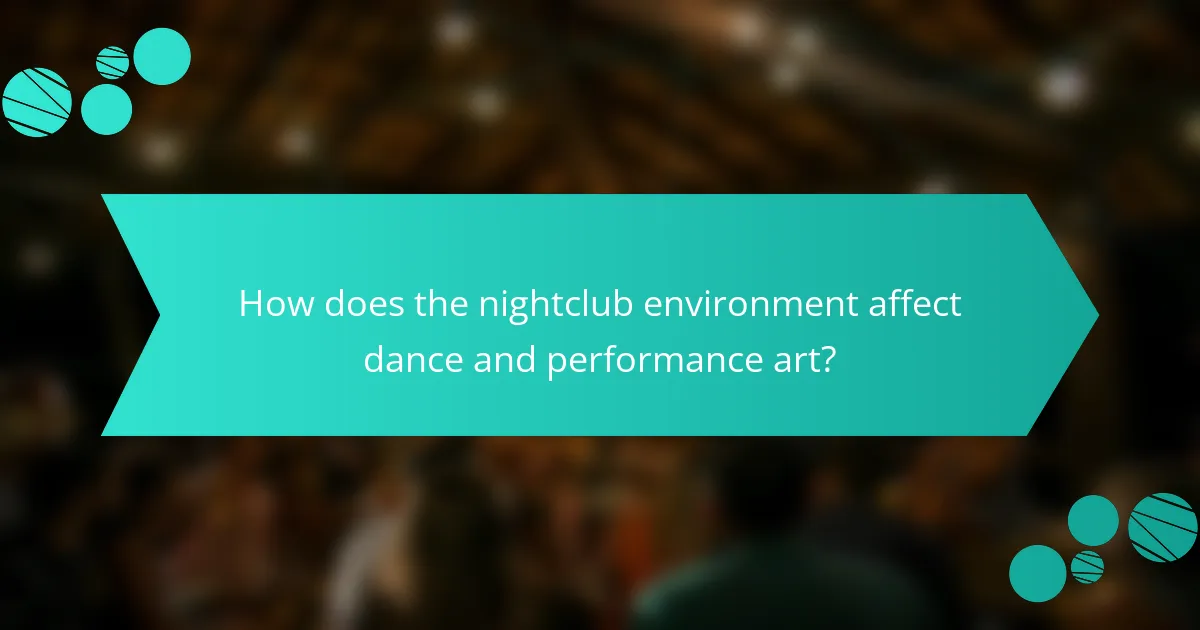Dance styles and performance art in French nightclubs represent a diverse range of expressive forms, including contemporary dance, ballet, hip-hop, and traditional French cancan. These styles contribute to the vibrant nightlife culture, particularly in cities like Paris and Marseille, where house, techno, and hip-hop dominate the scene. The nightclub environment, characterized by dim lighting and energetic music, enhances audience engagement and fosters creativity among performers. This article explores how the interplay of various dance styles and performance art creates a unique cultural experience, highlighting the significance of live performances and themed events in shaping the nightlife atmosphere.

What are Dance Styles and Performance Art in French Nightclubs?
Dance styles and performance art in French nightclubs encompass a variety of expressive forms. These include contemporary dance, ballet, hip-hop, and traditional French cancan. Each style contributes to the vibrant atmosphere of nightlife in France. Performance art often integrates music, visual elements, and audience interaction. French nightclubs frequently host live performances that showcase these dance styles. For instance, the famous Moulin Rouge is known for its cancan shows. This blend of dance and performance art creates a unique cultural experience. In major cities like Paris, nightclubs often feature themed events that highlight specific dance styles.
How have dance styles evolved in French nightclubs over the years?
Dance styles in French nightclubs have evolved significantly over the years. Initially, traditional dance forms like the cancan dominated the scene in the late 19th century. As the 20th century progressed, jazz and swing music influenced dance styles, introducing more improvisational elements. The emergence of disco in the 1970s brought about a shift towards more rhythmic and synchronized movements. In the 1980s and 1990s, electronic dance music led to the rise of styles such as house and techno, characterized by repetitive beats and fluid movements. The 2000s saw the incorporation of hip-hop and street dance styles, reflecting broader cultural trends. Today, French nightclubs feature a fusion of global dance styles, showcasing diversity and innovation. This evolution mirrors changes in music genres and societal influences within France.
What historical influences shaped the current dance styles?
Current dance styles are shaped by various historical influences. The Renaissance period introduced court dances that emphasized grace and formality. The influence of African rhythms and movements emerged during the slave trade, impacting genres like jazz and hip-hop. The emergence of ballet in the 17th century established foundational techniques and aesthetics. The 20th century saw the rise of social dances, influenced by jazz music and cultural exchanges. Additionally, technological advancements, such as the introduction of recorded music, transformed dance styles and accessibility. These historical contexts are essential in understanding the evolution of contemporary dance forms.
How do contemporary trends impact traditional dance forms?
Contemporary trends significantly influence traditional dance forms by introducing new styles and techniques. These trends often lead to the fusion of different dance genres. For example, hip-hop elements are increasingly incorporated into ballet and folk dances. This blending enhances creativity and attracts younger audiences. Social media platforms play a crucial role in promoting these hybrid styles. They allow dancers to showcase their work globally, increasing visibility. Additionally, contemporary choreography often emphasizes individual expression over strict technique. This shift encourages traditional dancers to adapt and innovate. As a result, traditional dance forms evolve while retaining their cultural significance.
What role does performance art play in the nightclub scene?
Performance art serves as a dynamic element in the nightclub scene. It enhances the overall atmosphere and engages patrons in unique experiences. Nightclubs often feature live performances that blend various art forms, including dance, music, and visual art. These performances can create a sense of community and shared experience among attendees.
Historical examples include the vibrant cabaret scene in Paris, where performers like Josephine Baker captivated audiences. Modern nightclubs continue this tradition, showcasing local and international artists. According to a study by the International Journal of Arts Management, performance art in nightclubs can increase customer retention and satisfaction. This demonstrates its significant role in enhancing the nightlife experience.
How does performance art enhance the overall nightclub experience?
Performance art enhances the overall nightclub experience by creating an immersive atmosphere. It engages patrons through visual stimulation and emotional connection. This form of art often incorporates dance, music, and theater, providing a multi-sensory experience. Performance art can elevate the energy of the venue, encouraging audience participation. It also fosters a sense of community among attendees, as shared experiences strengthen social bonds. Notably, venues that feature performance art often report increased customer retention and satisfaction. According to a study by the National Endowment for the Arts, 70% of attendees felt more connected to the venue due to live performances.
What types of performance art are commonly showcased in French nightclubs?
French nightclubs commonly showcase a variety of performance art types. These include cabaret performances, which often feature singing, dancing, and comedy. Burlesque shows are also popular, highlighting theatrical [censured] and elaborate costumes. Live music performances, ranging from DJs to live bands, are a staple in many venues. Additionally, contemporary dance acts and aerial performances are frequently presented. These art forms contribute to the vibrant nightlife culture in cities like Paris.

What are the most popular dance styles in French nightclubs?
The most popular dance styles in French nightclubs include house, techno, and hip-hop. House music, originating in Chicago, is characterized by its repetitive beats and synthesized sounds. Techno, known for its fast tempo and electronic elements, is widely embraced in Parisian clubs. Hip-hop reflects urban culture and is often accompanied by breakdancing. Additionally, electro and pop are also prominent in the nightlife scene. These styles cater to diverse audiences and influence the overall club atmosphere. According to a 2022 survey by Nightlife France, house and techno dominate the playlists in major cities like Paris and Marseille.
How do electronic dance music genres influence dance styles?
Electronic dance music genres significantly influence dance styles by dictating rhythm, tempo, and mood. Each genre, such as house, techno, or trance, has distinct characteristics that shape how dancers express themselves. For instance, house music typically features a steady 4/4 beat, encouraging fluid and groovy movements. In contrast, techno often has a faster tempo, prompting more energetic and mechanical dance styles. Trance music, known for its melodic build-ups, inspires emotive and expressive dance forms.
The evolution of these genres has led to the emergence of specific dance styles like shuffle dance, which aligns with the beats of house music, and the robotic movements associated with techno. Historical context shows that as electronic music evolved in French nightclubs, so did the corresponding dance styles. The integration of visual elements in performances further enhances the connection between music and movement.
What specific dance styles are associated with techno and house music?
The specific dance styles associated with techno and house music include the shuffle, voguing, and whacking. The shuffle is characterized by quick foot movements and a rhythmic style. Voguing involves striking poses and angular movements, often inspired by fashion. Whacking focuses on arm movements and expressive gestures. These styles emerged from the underground dance scenes in the 1980s and 1990s. They reflect the energetic and improvisational nature of techno and house music. Each style has its roots in various cultural influences, enhancing the diversity of dance in this genre. These dance forms are commonly seen in clubs and festivals worldwide.
How do cultural backgrounds influence dance styles in nightclubs?
Cultural backgrounds significantly influence dance styles in nightclubs. Different cultures bring unique rhythms, movements, and expressions to the dance floor. For example, Latin American cultures contribute salsa and bachata, characterized by their vibrant and sensual movements. African cultures often introduce energetic styles like afrobeat, which emphasize rhythm and body movement.
Asian influences can be seen in styles such as Bollywood dance, incorporating intricate hand gestures and storytelling. These cultural elements shape the overall atmosphere and engagement in nightclubs. A study by the Journal of Cultural Studies highlights how cultural identity impacts dance preferences and styles. This connection reinforces the diversity of dance experiences in nightlife settings.
What are the characteristics of traditional French dance styles?
Traditional French dance styles are characterized by their elegance, formality, and intricate footwork. These styles often emphasize graceful movements and precise choreography. Many traditional dances, such as the cancan, feature high-energy performances and vibrant costumes. Other styles, like ballet, focus on technique and poise. The influence of regional folk dances is also evident in traditional French dance. Historical context plays a significant role in shaping these dance forms. For example, the Renaissance period introduced court dances that prioritized social interaction and display. Overall, traditional French dance styles showcase a rich cultural heritage and artistic expression.
What unique attributes define styles like cancan and ballet?
Cancan and ballet are defined by their distinct techniques and performance styles. The cancan features high-energy kicks, rapid footwork, and vibrant costumes. It often includes playful and flirtatious themes, emphasizing theatrical expression. Ballet, in contrast, is characterized by its formalized movements, grace, and precision. It employs techniques like pointe work and fluid body lines. Ballet performances often convey narratives through choreography and require extensive training. Both styles have historical significance; the cancan emerged in 19th-century Paris, while ballet has roots in the Italian Renaissance. These unique attributes differentiate cancan and ballet in terms of movement, expression, and cultural context.
How do these traditional styles integrate into modern performances?
Traditional dance styles integrate into modern performances by blending historical techniques with contemporary choreography. This fusion creates a dynamic expression that appeals to diverse audiences. For instance, traditional movements are often incorporated into modern dance routines, enhancing the visual storytelling. Additionally, live music elements from traditional styles are frequently used in modern performances. This combination preserves cultural heritage while making it accessible to current generations. The use of traditional costumes in modern settings also adds visual authenticity. As a result, performers can pay homage to their roots while innovating within the art form. This integration reflects a broader trend in the performing arts, where cultural preservation meets modern creativity.

How does the nightclub environment affect dance and performance art?
The nightclub environment significantly influences dance and performance art. The atmosphere is characterized by dim lighting, loud music, and vibrant energy. These elements create an immersive experience that enhances performers’ expressions. The audience’s engagement is heightened in such settings, encouraging spontaneity and creativity. Research indicates that the social dynamics in nightclubs promote collaboration among artists. The physical space allows for diverse dance styles to flourish, adapting to the rhythmic beats. Furthermore, the nightlife culture often embraces experimental performances. This fosters innovation in choreography and artistic expression. Overall, the nightclub setting serves as a catalyst for dynamic and evolving performance art.
What elements of nightclub design enhance dance performances?
Lighting design enhances dance performances in nightclubs. Effective lighting creates an immersive atmosphere. It highlights dancers and their movements. Dynamic lighting changes can energize the crowd. Sound systems contribute significantly to the experience. High-quality audio enhances the rhythm and beats. Dance floors should be spacious and well-structured. This allows for fluid movement and crowd interaction. Mirrors can be used to amplify visual effects. They create a sense of depth and engagement. Overall, these design elements work together to elevate dance performances.
How does lighting impact the mood and style of dance?
Lighting significantly impacts the mood and style of dance. It creates an atmosphere that can enhance or alter the emotional experience of both dancers and the audience. Different colors and intensities of light evoke various feelings. For example, warm colors like red and orange can create a passionate and energetic vibe. In contrast, cooler colors like blue can evoke calmness or melancholy.
The style of dance is also influenced by lighting design. Bright, flashing lights may complement high-energy dance styles like techno or house. Softer, dim lighting may suit more intimate or lyrical performances. Studies show that lighting can affect the perception of movement. Dancers may adjust their performance based on the lighting conditions.
In French nightclubs, dynamic lighting is often synchronized with music. This synchronization enhances the overall experience, making the dance feel more immersive. The right lighting can transform a simple dance into a captivating performance. Thus, lighting is a crucial element in shaping the mood and style of dance.
What role does sound quality play in dance and performance art?
Sound quality is crucial in dance and performance art. It directly affects the audience’s experience and the performers’ execution. High sound quality enhances clarity in music and spoken words. This clarity allows dancers to synchronize movements with the rhythm effectively. Poor sound quality can lead to miscommunication between performers and disrupt the flow of the performance. Studies show that audiences are more engaged when sound quality is high. For instance, a 2018 study by the University of Arts London found that sound clarity significantly impacts emotional responses during performances. Thus, sound quality plays an essential role in the overall success of dance and performance art.
How do audience interactions influence dance performances?
Audience interactions significantly influence dance performances. Dancers often adjust their movements based on audience reactions. Positive responses can enhance a dancer’s energy and creativity. Conversely, negative reactions may lead to decreased performance quality. Research indicates that audience engagement can elevate the overall experience for both performers and viewers. For example, a study by the University of California found that interactive performances received higher audience satisfaction ratings. This dynamic relationship creates a feedback loop that shapes the performance in real-time. Ultimately, audience interactions play a crucial role in the success and evolution of dance performances in settings like French nightclubs.
What are common ways audiences engage with performers?
Audiences commonly engage with performers through applause, cheers, and vocal encouragement. These actions express appreciation and support during performances. Additionally, audiences may dance along, creating an interactive atmosphere. Social media engagement is another key way, with attendees sharing experiences online. Eye contact and direct interaction can enhance the connection between performers and audiences. Some audiences participate by requesting songs or specific performances. Merchandise purchasing also signifies engagement, as fans buy items to support their favorite performers. Each of these methods fosters a sense of community and shared experience during performances in French nightclubs.
How does audience participation affect the overall performance dynamic?
Audience participation significantly enhances the overall performance dynamic. It creates a more engaging atmosphere for both performers and attendees. When the audience actively participates, performers often respond with increased energy and creativity. This interaction can lead to spontaneous moments that elevate the performance. Research shows that performances with high audience engagement receive better feedback and ratings. For instance, a study in the Journal of Performance Studies found that audience involvement can improve the emotional impact of a performance. Thus, audience participation is crucial for a vibrant and dynamic performance experience.
What tips can enhance the experience of dance and performance art in nightclubs?
Incorporating interactive elements can enhance the experience of dance and performance art in nightclubs. Engaging the audience through participation creates a dynamic atmosphere. Utilizing diverse music styles can cater to various tastes, encouraging more people to join in. High-quality lighting effects can elevate performances, making them visually captivating. Offering themed nights can attract specific crowds and enhance the overall experience. Providing comfortable spaces for relaxation allows attendees to recharge between high-energy performances. Ensuring excellent acoustics improves sound quality, making performances more enjoyable. Lastly, featuring local artists can create a sense of community and support the local arts scene.
How can attendees choose the best nightclubs for unique dance experiences?
Attendees can choose the best nightclubs for unique dance experiences by researching venue reviews and event schedules. They should look for clubs known for specific dance styles or performances. Popular options often feature renowned DJs or live performers. Attendees can also check social media platforms for videos showcasing the club’s atmosphere. Visiting during themed nights can enhance the experience. Additionally, word-of-mouth recommendations from friends can provide valuable insights. Clubs with a diverse dance floor and innovative lighting often create memorable environments. Exploring venues outside mainstream choices may lead to discovering hidden gems.
What should performers consider to engage their audience effectively?
Performers should consider their audience’s preferences and emotional responses to engage effectively. Understanding the demographic allows performers to tailor their content. Engaging storytelling can captivate attention and create a connection. Visual elements, like costumes and lighting, enhance the overall experience. Interaction with the audience fosters a sense of participation. Timing and pacing are crucial for maintaining energy levels. Unique choreography can leave a lasting impression. Research shows that audience engagement increases satisfaction and retention in performances.
Dance styles and performance art in French nightclubs represent a rich tapestry of cultural expression, featuring genres such as contemporary dance, ballet, hip-hop, and traditional cancan. The article explores the evolution of these dance styles, influenced by historical contexts and contemporary trends, showcasing how they have adapted over time. It highlights the significant role of performance art in enhancing the nightclub experience, fostering audience engagement, and creating immersive environments. Additionally, the piece examines the impact of electronic music genres on dance styles and the importance of nightclub design elements, such as lighting and sound quality, in shaping performances.